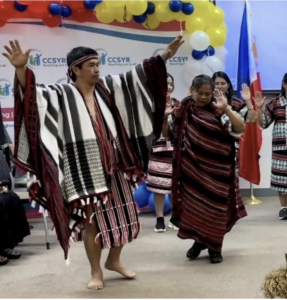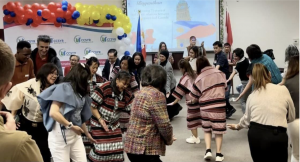Kabenguetan Dance as community building and education
Kabenguetan Dance as community building and education
 By Gretchen Mangahas
By Gretchen Mangahas
Founder & President of Kabenguetan Dance Troupe (Formerly the Association of Indigenous Peoples of Benguet)
Performing at the 75th anniversary celebration of Philippines-Canada Relations hosted by the Canadian Catholic Services for the York Region, Kabenguetan Dance Troupe founder and president Gretchen Shagami Mangahas delivered this brief introduction to their presentation.
Mapteng jen akew yu, em-in. Good morning, everyone.
We represent the indigenous people from Benguet Province of the Cordillera Administrative Region in the Northern Philippines collectively known as Igorots. As settlers, we bring with us cultural values, tradition and practices that we use in our daily life. Just like any other immigrant, we face a lot of issues that involve settlement, immigration and employment. On top of that, we also bring with us our minority identity that we hold from back home in the Philippines when we migrate to another country like Canada. We use cultural presentations as a space for us to represent ourselves and to let Filipino-Canadians and the larger community know that we are here, we exist, and we would like to take part in the conversations.

Dancers: Julie Dalmacio, Rowena Bulon; Marion Dapliyan; Roselyn Cosala, Advisers, Kabenguetan Dance Troupe; Ray Pagnas,; Judy Mesa
Musicians: Hubert Nabus Jr.; Leo Pacito; Harold Sukaw; Clarence Lingaling
The Kabenguetan Dance Troupe was established in August 2022. We use dance for intergenerational storytelling and passing on our culture to the younger generations. When an Igorot immigrates to another country or a foreign space, the first thing that an Igorot does is to look for their community. And that is why Filipino indigenous-led organizations like the Kabenguetan as an association of indigenous peoples of Benguet from the 13 municipalities of the province come together with around 500 members strong.
Today, we will perform two dances. The first dance is called the “Tayaw” which is a Kankana-ey word for “fly.” The Tayaw is performed by a man and a woman usually associated with the Kanyaw during the celebration of weddings, curing rituals, death anniversaries and other festivities. It is a dance ritual that shows expression of feast, joy or celebration.
The second dance is a community dance called the “Bindiyan” which originated in the town of Kabayan. It is called “Bindiyan” because dancers need to perform it ritually until they tire and until the last drop of rice wine called tapey is finished. The Bindiyan is a unity, victory and thanksgiving dance with 12 positions to demonstrate the farming preparations and harvest of the Benguet Kintoman rice. Narito kami. We are here. We are more than just our dance, our clothing and our practices. If you would like to know more about who we are and be one with us as a community, we are here. We have something to contribute to support the aspirations of the larger community.
Comments (0)